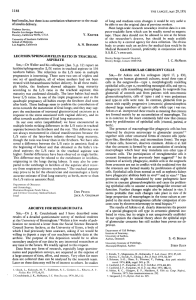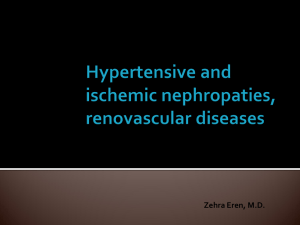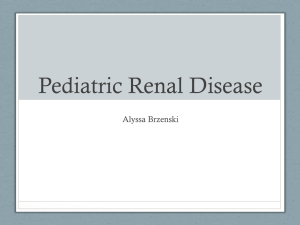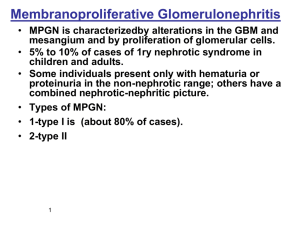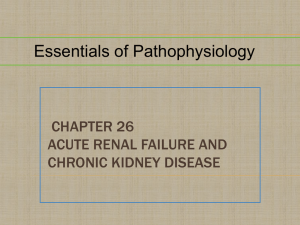Histopathologic Classification of ANCA
advertisement
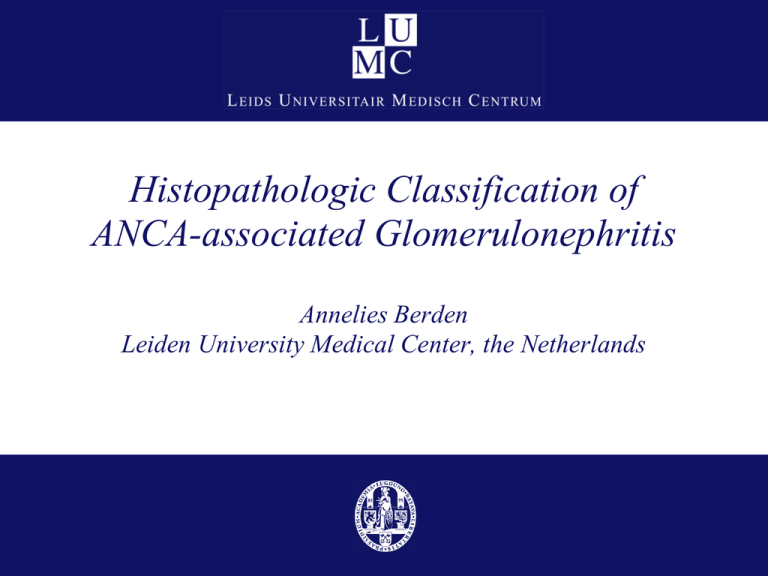
Histopathologic Classification of ANCA-associated Glomerulonephritis Annelies Berden Leiden University Medical Center, the Netherlands ANCA-associated vasculitis • Systemic small vessel vasculitis • Incidence 10-20 persons/million/yr • Mean age at onset 65-74 yr • Men and women equally affected • GPA (Wegener’s) / MPA Autoimmune disease Neutrophil + Infection + ANCA TNF-α Priming ANCAneutrophil interaction Vasculitis Adopted from Trends Immunol 26: 561-564 Heeringa et al. End organ damage • Kidneys • Most frequent cause of RPGN • Dialysis, transplantation • Lungs • Alveolar hemorrhage • Ear-nose-throat • Saddle nose deformity • Joints, skin, nervous system Prognosis and treatment • Untreated → fatal disease • 1 year mortality 80% • 1960’s/1970’s → dramatic improvement with corticosteroids and cyclophosphamide • > 90% of patients achieving remission at 1 year • Induction and remission maintenance therapy • Cyclophosphamide, rituximab • Azathioprine, methotrexate, mycophenolate mofetil Immunosuppressive therapy: a double-edged sword • Complications of therapy • Infertility • Infections • Malignancies • Limited long term effectiveness • 80% survival 5-8 yr fu • 20-40% ESRF 3-5 yr fu • 50% relapse within 5 yr fu The renal biopsy • Gold standard for diagnosis • Hallmark microscopy findings: • (IF) Pauci-immune staining pattern • Little-no glomerular staining for immunoglobulin or complement • (LM) Crescents (cellular- fibrocellular – fibrous) • (LM) Fibrinoid necrosis • (EM) Subendothelial edema, microthrombosis, degranulation of neutrophils • Prognostic value? Standardized scoring form • Diagnostically description ‘necrotizing, crescentic GN’ suffices • Scoring form devised to assess prognostic value • Systematically quantify the extent to which various morphological parameters appear in a biopsy • Assess which are most valuable in predicting renal outcome • Scoring of an extensive number of lesions quantitatively or dichotomously (present/absent scale) • In general better intra- and interobserver agreement on quantitative data (such as crescents and glomerulosclerosis) Bajema et al. NDT‘96 Scoring form glomerular lesions Bajema et al. NDT‘96 Scoring form interstitial lesions Bajema et al. NDT‘96 Using the scoring system to assess prognostic value… Tubular lesions predict renal outcome in AAGN after rituximab therapy. EUVAS, JASN ‘12 Clinical and histologic determinants of renal outcome in AAV: A prospective analysis of 100 patients with severe renal involvement. EUVAS, JASN ‘06 An index for renal outcome in AAGN. EUVAS, AJKD ‘03 Determinants of outcome in AAGN: a prospective clinico-histopathological analysis of 96 patients. EUVAS KI ‘02 Long-term renal injury in AAV: analysis of 31 pts with follow-up biopsies. EUVAS, NDT ‘02 Renal histology in AAV: differences between diagnostic and serologic subgroups. EUVAS KI ‘02 Kidney biopsy as a predictor for renal outcome in AAGN. KI ‘99 Prognostic value of renal histologic lesions • Positive predictors of (long-term) renal outcome • Normal glomeruli • Cellular crescents • Negative predictors of (long-term) renal outcome • Globally sclerotic glomeruli • Fibrous crescents • Tubular atrophy Towards a classification system • Abundance of literature on prognostic value of histologic parameters in the renal biopsy • >15 years of experience in renal histology group EUVAS • Incentive for development of classification system Any classification system should comprise the following: • Enhance the quality of communication, especially between experts involved in the field • Provide a logical structure for categorization of groups for epidemiologic, prognostic or interventional studies (clinical trials) • Assist in the management of individual patients; to this extent, categories should be mutually exclusive and predictive of the subsequent behavior of the disease (prognosis) Glassock 2004 Proposed classification system • Four general categories: • Focal class ≥ 50% normal glomeruli • Crescentic class ≥ 50% cellular crescents • Mixed class • Sclerotic class ≥ 50% globally sclerotic glomeruli • Hinges on recognition of: • normal glomeruli, cellular crescents, global glomerulosclerosis Normal glomeruli • No vasculitic lesions or global sclerosis • May show subtle changes as result of ischemia or a minimum number of inflammatory cells (<4 neutrophils, lymphocytes or monocytes) • Exclusion criteria: • Synechiae • Local/segmental glomerulosclerosis • Extensive ischemic changes (splitting of Bowman’s capsule, wrinkling of the GBM) • Any other lesion unrelated to vasculitis (amyloid, tram tracking) Crescents • Cellular crescents (classification) • Purely cellular lesions or with cellular components >10% • Fibrous crescents • Fibrotic (sclerotic) lesions with fibroblasts filling Bowman’s space • >90% of crescent consists of extracellular matrix Development of a crescent, early stage Development of a crescent, later stage Development of a crescent: fibrous crescent Development of a crescent (Atkins, 1998) Global glomerulosclerosis • Sclerotic changes in the glomerulus comprising more than 80% of the tuft • Irrelevant whether global glomerulosclerosis is attributable to ANCA-associated GN or not Four histopathological classes of ANCA-associated GN Prognostic value • Renal survival 1yr • Focal 93% • Crescentic 84% • Mixed 69% • Sclerotic 50% First validation study Discussion/ Conclusions • Straightforward classification system for ANCA-ass. GN developed by international group of renal pathologists • Proved practical and of predictive value • Needs further validation and according amendments • Prospective studies • Tubulointerstitial lesions in our hands no relevant increase in predictive value and because of semi-quantitative lesions expected increase in intra/interobserver variation • Not validated for overlap syndromes (such as with anti-GBM disease) Thank you for your attention! Morita, Suzuki and Churg, 1973 Important observation 1: * Three stages of crescent development were observed: cellular – fibrocellular – fibrous Morita, Suzuki and Churg, 1973 Important observation 2: * Breaks in the basement membrane of capillary loops were often found: it is agreed that formation of crescents is provoked by a substance or substances that escape from the glomerular capillaries into Bowman’s space, most often fibrin Morita, Suzuki and Churg, 1973 Important observation 3: * Macrophages were noticed, as well as fibrin, red blood cells, white blood cells and fine strands suggestive of basement membrane (numerous in fibrous strands) Light microscopy of breaks in the GBM leading to crescent formation Morita, Suzuki and Churg, 1973 Important observation 4: * EM: Podocytes participated in crescent formation to a limited extent Podocyte (PC) attached to the crescent cells by intercellular junctions (arrows), x 5700. The crescent What is it: a lesions at the location of Bowman’s space, multilayered, consisting of epithelial cells, macrophages, inflammatory cells, fibrin, fibrinoid necrosis, other cells. It may be segmental or circumferential, cellular – fibrocellular or fibrous What causes it: breaks in the GBM disturbed process of regeneration of podocytes What is the outcome: depends on the type of renal disease they appear in strong relation to outcome in AAV

